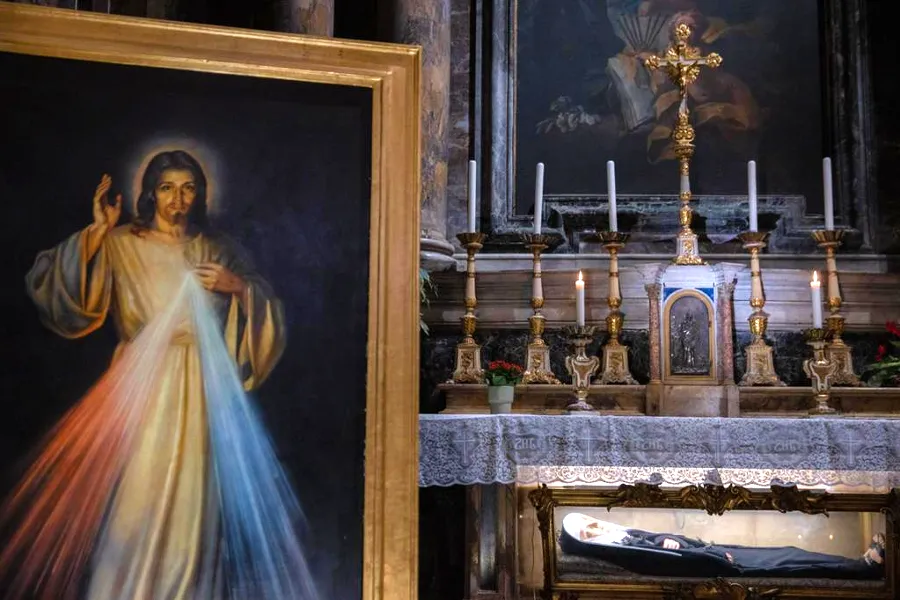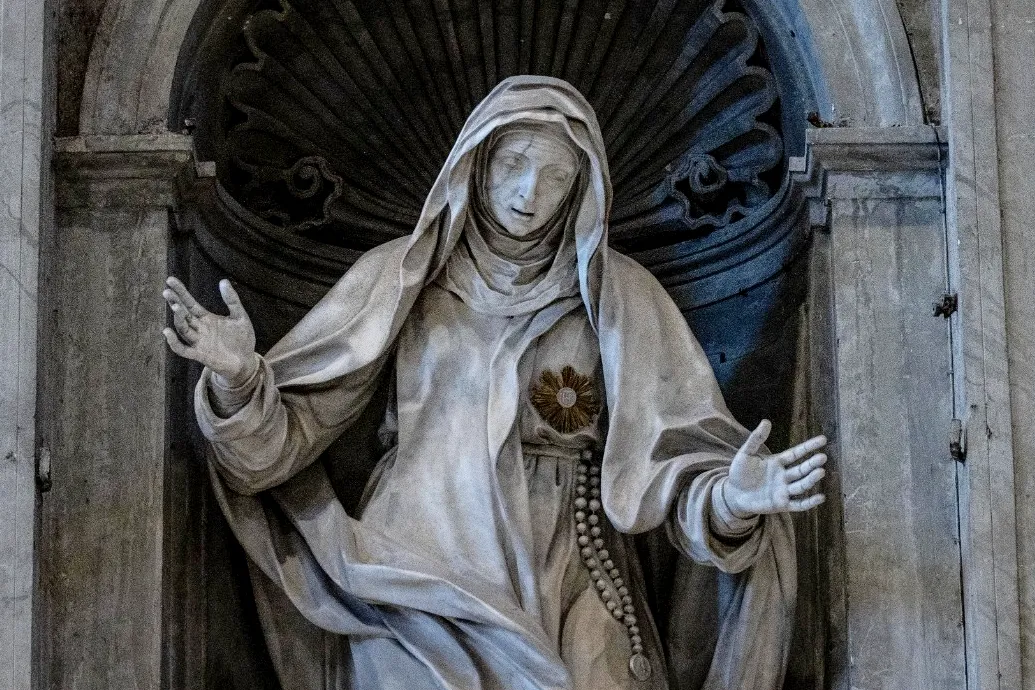How the Eucharist Entered the Heart of a 13th-Century Saint and Inspired a Sister of Life
Since taking Juliana as her religious name, Sister Juliana Faustina has heard testimonies from lay people and doctors who have seen Falconieri’s intercession work powerfully for those suffering from serious illnesses.

This is the story of how an obscure 13th-century saint from Florence inspired a young religious sister in Manhattan — and then utterly surprised her.
“It was not so much that I discovered St. Juliana, as that she found me, and showed herself to be a friend to me, a ‘big sister’ in the spiritual life,” Sister Juliana Faustina told CNA.
“St. Juliana has taught me that it is through the Eucharist, particularly through Holy Communion, that our hearts are day by day transformed more into the Heart of Christ,” she said.
Born just six years after Pope Urban IV instituted the feast of Corpus Christi, St. Juliana Falconieri (1270-1341) devoted her life to prayer and works of mercy as the foundress of the Servite nuns, until she became so sick that she was unable to receive Holy Communion.
Devastated by this loss of union with Christ’s true presence in the Eucharist, St. Juliana asked a priest to lay the Eucharist upon a corporal over her heart.
When the priest did this, the Eucharist disappeared and Juliana died. Branded on her skin above her heart was an image of the Eucharist with a crucifix in its center and rays surrounding the host. The Eucharist had entered her heart.
A large marble statue in St. Peter’s Basilica, to the left of the twisting columns of Bernini’s soaring baldacchino, captures that exact moment. St. Juliana is seen with her arms outstretched in ecstasy as rays of gold radiate from a Sacred Host above her heart.
The feast of St. Juliana is on June 19, the same day that many Catholic dioceses will celebrate the Solemnity of the Most Holy Body and Blood of Christ this year.
A sisterhood spanning 700 years
The Sisters of Life are a religious order dedicated to protecting the sacredness of human life, particularly by caring for women who are pregnant and their unborn children.
As Sister Juliana Faustina was discerning her religious name with the order, she noticed a convergence in the spirituality between two female saints: St. Juliana Falconieri and St. Faustina Kowalska, the 20th-century Polish nun to whom Jesus appeared with a message of Divine Mercy.
“When I was preparing to enter religious life, I read a section of St. Faustina’s Diary where she sees the rays of Divine Mercy radiate forth from the Blessed Sacrament during Adoration on the Feast of Corpus Christi.”
“Jesus spoke to her and said, ‘These rays of mercy will pass through you, just as they have passed through this Host, and they will go out through all the world,’” she said.
“These words were a summons for me, as well, to let the Heart of Jesus be so alive in me that my heart could be another place where His love and mercy enter this world,” she said.
“I was struck by the thought of St. Juliana as a model of this, particularly since those who witnessed her Eucharistic miracle described the ‘rays’ around the image of the Eucharist imprinted on her heart.”
Finding Falconieri
It was during a phone call with Sister Juliana amid the COVID-19 pandemic that I first learned about St. Juliana Falconieri.
The saint caught my attention because she had been deprived of the Eucharist for reasons outside of her control, as so many of us in Europe had experienced during months of strict lockdown measures.
At the end of our phone call, Sister Juliana asked a bit shyly if I could do her a favor and find out where Falconieri was buried in Italy.
Finding Falconieri’s tomb quickly became one of the top items on my bucket list. Some digging in Italian sources revealed that her tomb was to be found inside the Basilica della Santissima Annunziata (Basilica of the Most Holy Annunciation) in Florence — an easy day trip from Rome by train.
A surprise at the tomb
The church containing St. Juliana Falconieri’s tomb is located just around the corner from Florence’s Accademia Gallery, where tourists push and shove to get a photo of Michelangelo’s David sculpture.
Despite its location in the heart of Florence, less than a 10-minute walk from Filippo Brunelleschi’s Duomo, the basilica was nearly empty when I stepped inside.
But what I saw when I approached St. Juliana’s tomb stunned me. There, right beside the tomb, was the Divine Mercy image inspired by St. Faustina.
Sister Juliana Faustina’s two new names were united in the side chapel of the basilica. I was so excited to send a letter to the convent to tell Sister Juliana Faustina what I had discovered.
For the Sister of Life, it was a confirmation of the grace she had received in praying about her religious name.
“I was so happy,” Sister Juliana said.
“For me, the Eucharist and Divine Mercy go hand in hand, so I felt the image being placed beside St. Juliana was very fitting.”
“[It was] … a little sign of love that my two patron saints know each other in heaven and are friends, interceding together for me,” she added.
Who was St. Juliana Falconieri?
Born into a wealthy merchant family in 1270, Falconieri was a contemporary of Dante Alighieri in the medieval Republic of Florence.
Her paternal uncle was St. Alexis Falconieri, one of the “Seven Holy Founders” of the Servants of Mary, also known as the Servites, in Florence. He had experienced a vision of the Blessed Virgin Mary on the feast of the Assumption in 1233 and was considered a mystic — though he refused priesthood because he considered himself unworthy.
The example of Juliana’s uncle moved her to desire to consecrate her whole life to God and she declined a marriage proposal from a wealthy young suitor, despite pressure from her parents to accept it. She donned a religious habit at the age of 14 in 1284.
As a nun, Juliana dedicated herself to works of mercy, particularly caring for the sick. She would visit the dying in the Hospital of Santa Maria Nuova, the oldest hospital still active in Florence today. The hospital was founded by the father of Beatrice Portinari, who is believed by some to be the real-life inspiration for Dante’s beloved.
Under the direction of her uncle, Juliana founded the female branch of the Servants of Mary. The sisters fasted on Wednesdays and Fridays each week and were known around Florence for their large black religious habits.
As she neared the age of 70, Juliana began to suffer from terrible stomach pains to the point where she was unable to swallow. The Eucharistic miracle on the day of her death occurred on June 19, 1341.
An intercessor for the sick
Since taking Juliana as her religious name, Sister Juliana Faustina has heard testimonies from lay people and doctors who have seen Falconieri’s intercession work powerfully for those suffering from serious illnesses.
“I’ve been surprised at how many people hear my name and share stories of how they’ve experienced St. Juliana Falconieri’s intercession,” she said.
“I think St. Juliana shows us that suffering, illness, and even death are no longer obstacles to our union with Christ. Rather, through the Cross of Jesus, they actually become moments where we can experience the greatest intimacy and union with Him,” she explained.
At a time when many people are tempted to despair that their suffering is meaningless, Sister Juliana sees Falconieri as a hopeful witness that these moments of suffering “are actually bursting with meaning.”
“If Jesus desired to draw so near to St. Juliana as to actually allow this miracle, where His Eucharistic Heart entered into hers, we must believe that He desires just as ardently to draw near to each of us in our own moments of trial,” she said.
“With hearts united to His, we are not suffering in vain, but participate in the love of His own Heart which, precisely through His Passion and Death, brought about the redemption of the world.”





















